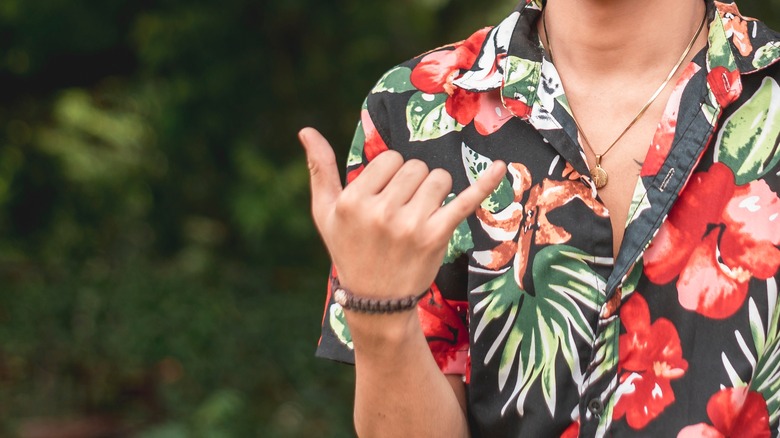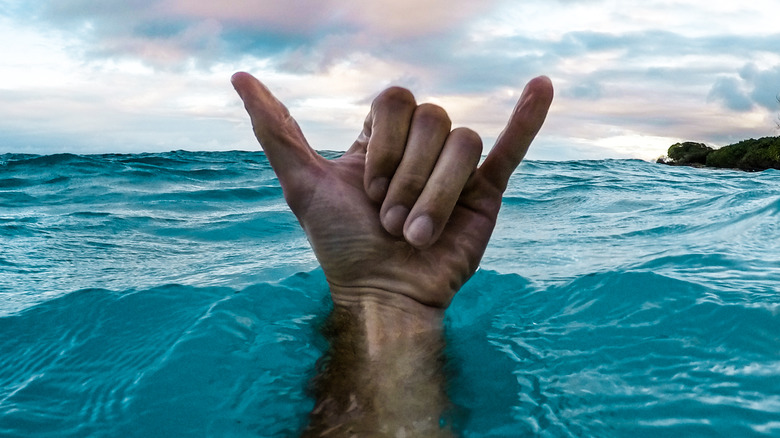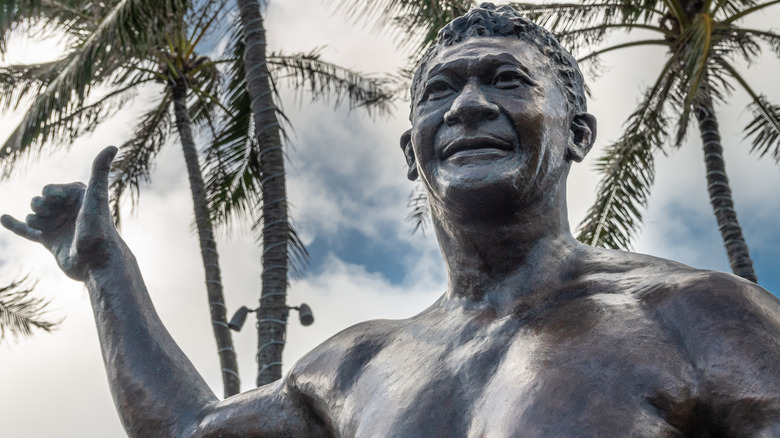The Origin Of The Famous Shaka 'Hang Loose' Greeting Isn't Nearly As Positive As One Would Think
One of the great pleasures of traveling the world, for those privileged enough to do so, is the chance to become immersed in a different culture. To learn and utilize another language, to visit iconic places and landmarks — it's a truly enriching experience.
In 2018, the Center For Immigration Studies reported that 67.3 million citizens of the United States over the age of 5 spoke a language aside from English at home. This is just a snapshot of the great global community we have become, but at times, a gesture can say much more than any words.
The "hang loose" hand gesture — aka the shaka sign — seems to speak of happiness, effortless coolness, and casualness. This may very well be how it tends to be employed today, but this wasn't always the case. The gesture, sadly, seems to have its origins in a tragic, finger-crushing accident. There are various different takes on the tale, but here's what is said to have happened.
The best of good vibes
In January 2013, per USA Today, then-President Barack Obama attended the Inauguration Parade. Obama, Britannica reports, was born in Honolulu, and the parade was the perfect occasion for him to perform a certain famous hand gesture. He and then-First Lady Michelle Obama, USA Today goes on, were photographed making a sort of half-fist, with their pinkie fingers and thumbs outstretched. The gesture, which needs no introduction for many, is the famous shaka "hang loose" sign.
The meaning of the gesture is easy to convey, but perhaps much harder to explain in a literal sense. As Saa Tamba of Kaua'i's Tamba Surf Company put it to Atlas Obscura, the gesture is " ... a way of saying hi, a way of saying goodbye, and spreading some good spirit, you know, the eternal spirit of aloha."
In these trying times, there could be nothing more fitting. We're very preoccupied with good and bad vibes, positive and negative energy, and green and red flags, and no hand gesture quite exudes all things good, positive, and green like the symbolic shaka signal. Like a smile, it sends an instant message: I'm good, and I'm sending you some aloha to be sure you are, too.
There isn't a clear-cut origin story for the super-chill shaka, but it tends to be connected with the grim story of a worker who lost several digits on a Hawaii sugar plantation.
Hamana Kalili seems to have started it all
Hawaiian Airlines states the injured person was one Hamana Kalili. Kalili was an employee of the Kahuku Sugar Mill at the turn of the 20th century. The story details how the unfortunate worker got a hand caught in the machine that squishes the cane. Kalili's index, middle, and ring fingers were pulverized.
According to the Honolulu Star-Bulletin, Kalili's grandnephew, Vonn Logan of Brigham Young University-Hawaii, said that children would try to hop on the train that transported the sugar, and Kalili was tasked with warding them away from it. They, in turn, started to signal each other. "Since [Kalili] lost his fingers, the perfect signal was what we have now as the 'shaka sign,'" Logan reportedly said. "When he waved, the wave was of his shaka," he added.
The Honolulu Star-Bulletin, however, also refers to the story as simply being "the prevailing local lore," and states that several other legends of fingers lost in accidents have been suggested as the origin of the gesture. One example is an attempt at dynamite fishing going awry.
As the Hawaii Ocean Project states, there is also debate about the origins of the name shaka itself. "Shaka, brah!" was the catchphrase of David Espinda, or Lippy, in his TV ads for cars. But it is unconfirmed whether Lippy truly "named" the iconic gesture. Ultimately, it doesn't matter. It's a proud tradition, an emotive gesture, and a meaningful signal of something very important.


